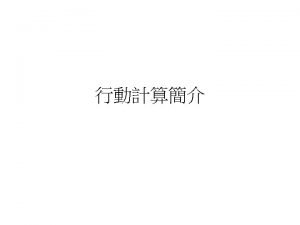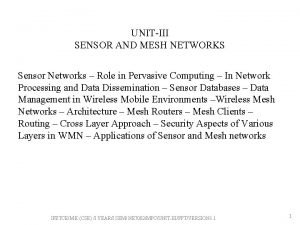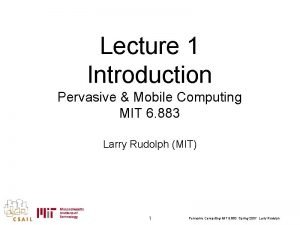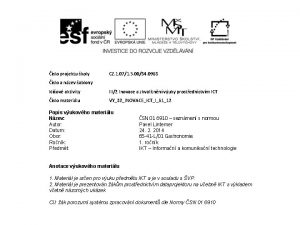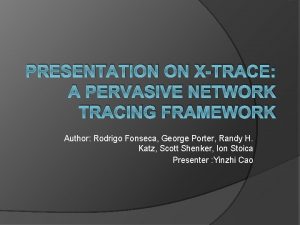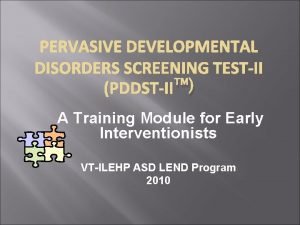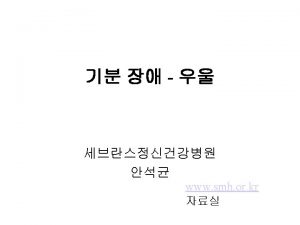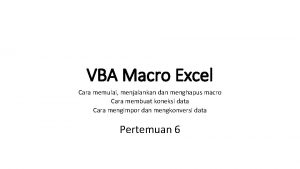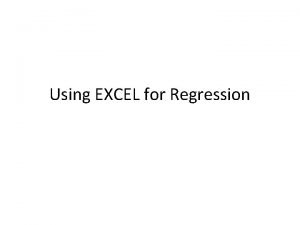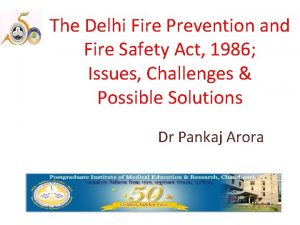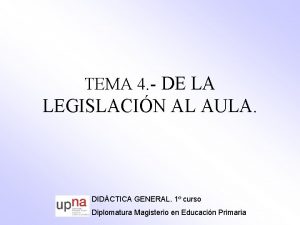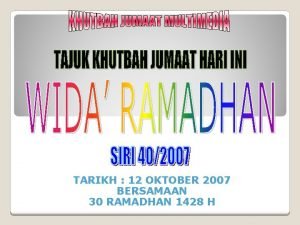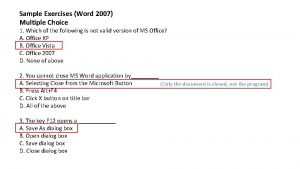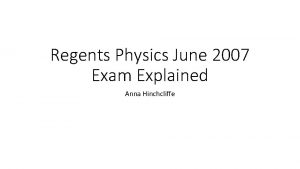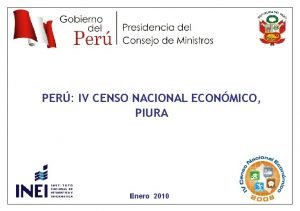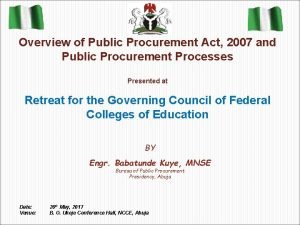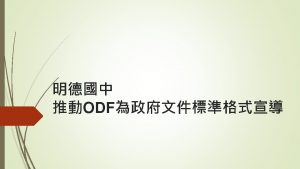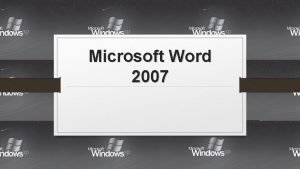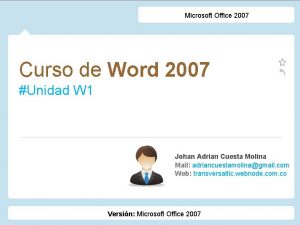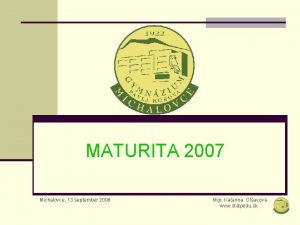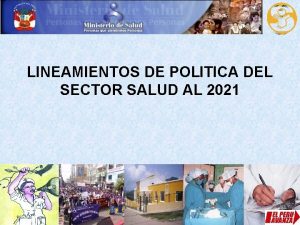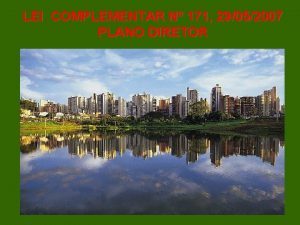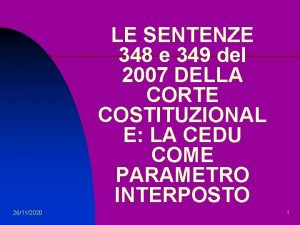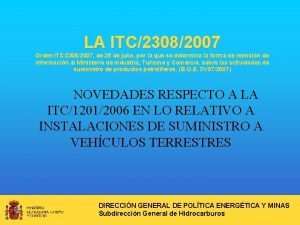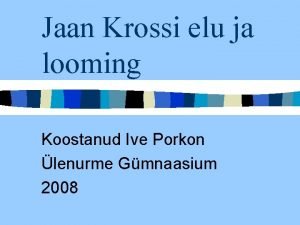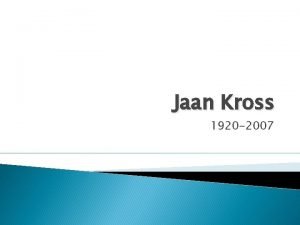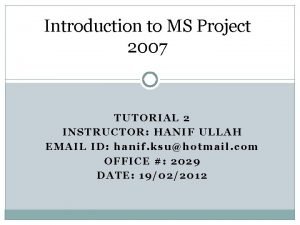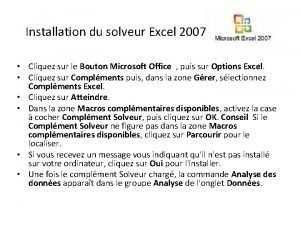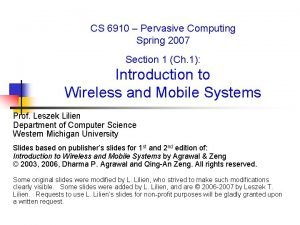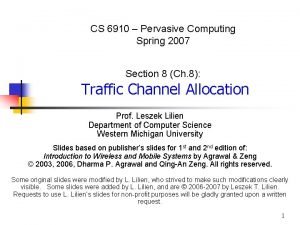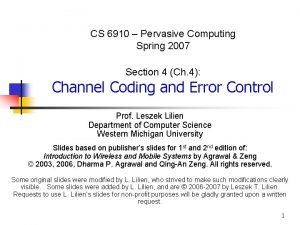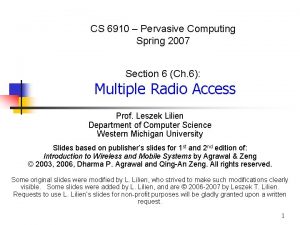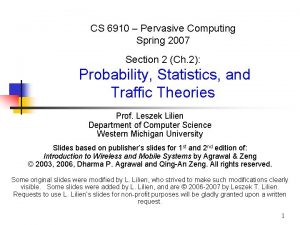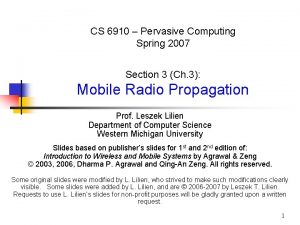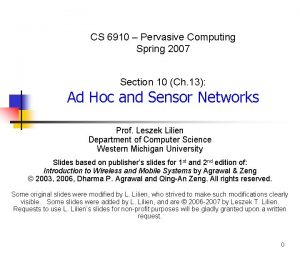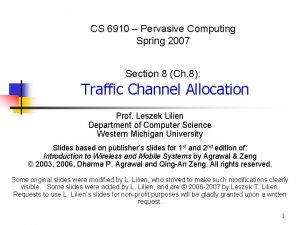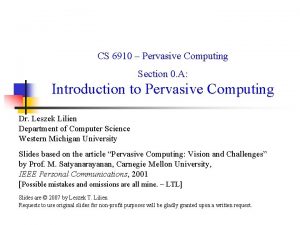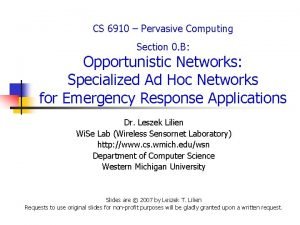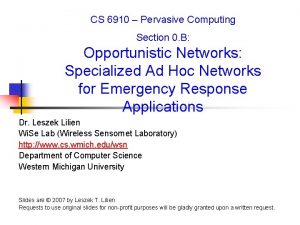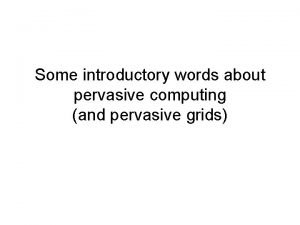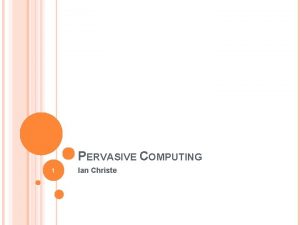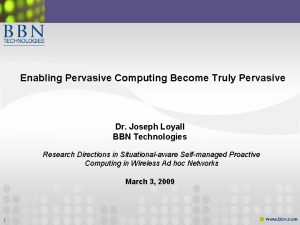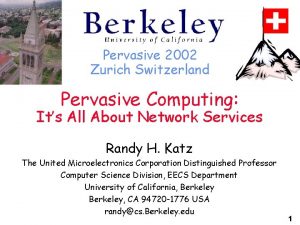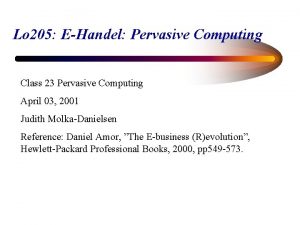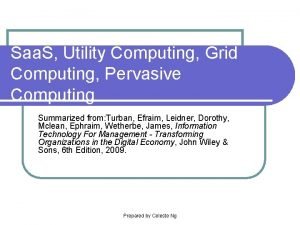CS 6910 Pervasive Computing Spring 2007 Section 5




![5. 2. Cell Area [LTL] n n n Cell size & shape are most 5. 2. Cell Area [LTL] n n n Cell size & shape are most](https://slidetodoc.com/presentation_image_h2/709b9acf061d239533dc835282dba73e/image-5.jpg)

![5. 3. Signal Strength and Cell Parameters [http: //en. wikipedia. org/wiki/DBm] n d. Bm 5. 3. Signal Strength and Cell Parameters [http: //en. wikipedia. org/wiki/DBm] n d. Bm](https://slidetodoc.com/presentation_image_h2/709b9acf061d239533dc835282dba73e/image-7.jpg)
![5. 3. Signal Strength and Cell Parameters – cont. [http: //en. wikipedia. org/wiki/DBm] n 5. 3. Signal Strength and Cell Parameters – cont. [http: //en. wikipedia. org/wiki/DBm] n](https://slidetodoc.com/presentation_image_h2/709b9acf061d239533dc835282dba73e/image-8.jpg)



























![Neighboring Clusters for a Reference Cell – cont. 2 n n [Repeated] N = Neighboring Clusters for a Reference Cell – cont. 2 n n [Repeated] N =](https://slidetodoc.com/presentation_image_h2/709b9acf061d239533dc835282dba73e/image-36.jpg)
















- Slides: 52

CS 6910 – Pervasive Computing Spring 2007 Section 5 (Ch. 5): Cellular Concept Prof. Leszek Lilien Department of Computer Science Western Michigan University Slides based on publisher’s slides for 1 st and 2 nd edition of: Introduction to Wireless and Mobile Systems by Agrawal & Zeng © 2003, 2006, Dharma P. Agrawal and Qing-An Zeng. All rights reserved. Some original slides were modified by L. Lilien, who strived to make such modifications clearly visible. Some slides were added by L. Lilien, and are © 2006 -2007 by Leszek T. Lilien. Requests to use L. Lilien’s slides for non-profit purposes will be gladly granted upon a written request. 1

Chapter 5 Cellular Concept Copyright © 2003, Dharma P. Agrawal and Qing-An Zeng. All rights reserved 2

Outline n n n n n Cell Shape n Actual cell/Ideal cell Signal Strength Handoff Region Cell Capacity n Traffic theory n Erlang B and Erlang C Cell Structure Frequency Reuse Distance Cochannel Interference Cell Splitting Cell Sectoring Copyright © 2003, Dharma P. Agrawal and Qing-An Zeng. All rights reserved 3

5. 1. Introduction n Cell (formal def. ) = an area wherein the use of radio communication resources by the MS is controlled by a BS n Cell design is critical for cellular systems n Size and shape dictate performance to a large extent n n For given resource allocation and usage patterns This section studies cell parameters and their impact Copyright © Leszek 2003, Dharma P. Agrawal and Qing-An Zeng. All rights reserved © 2007 by T. Lilien 4
![5 2 Cell Area LTL n n n Cell size shape are most 5. 2. Cell Area [LTL] n n n Cell size & shape are most](https://slidetodoc.com/presentation_image_h2/709b9acf061d239533dc835282dba73e/image-5.jpg)
5. 2. Cell Area [LTL] n n n Cell size & shape are most important parameters in cellular systems Informally, a cell is an area covered by a transmitting station (BS) (with all MSs connected to and serviced by the BS) Recall: n Ideal cell shape (Fig. a) is circular n Actual cell shapes (Fig. b) are caused by reflections & refractions n n n Also reflections & refractions from air particles Many cell models (Fig. c) approximate actual cell shape Hexagonal cell model most popular Square cell model second most popular R R R Cell R (a) Ideal cell (b) Actual cell R (c) Different cell models Copyright © 2003, Dharma P. Agrawal and Qing-An Zeng. All rights reserved (Modified by LTL) 5

Impact of Cell Shape & Radius on Service Characteristics n n Note: Only selected parameters from Table will be discussed (later) For given BS parameters, the simplest way of increase # of channels available in an area, reduce cell size n Smaller cells in a city than in a countryside Copyright © 2003, Dharma P. Agrawal and Qing-An Zeng. All rights reserved (Modified by LTL) 6
![5 3 Signal Strength and Cell Parameters http en wikipedia orgwikiDBm n d Bm 5. 3. Signal Strength and Cell Parameters [http: //en. wikipedia. org/wiki/DBm] n d. Bm](https://slidetodoc.com/presentation_image_h2/709b9acf061d239533dc835282dba73e/image-7.jpg)
5. 3. Signal Strength and Cell Parameters [http: //en. wikipedia. org/wiki/DBm] n d. Bm (used in following slides) = an abbreviation for the power ratio in decibel (d. B) of the measured power referenced to 1 m. W (milliwatt) n d. Bm is an absolute unit measuring absolute power n n n Since it is referenced to 1 m. W In contrast, d. B is a dimensionless unit, which is used when measuring the ratio between two values (such as signal-to-noise ratio) Examples: n n 0 d. Bm = 1 m. W 3 d. Bm ≈ 2 m. W n n Since a 3 d. B increase represents roughly doubling the power − 3 d. Bm n ≈ 0. 5 m. W Since a 3 d. B decrease represents roughly cutting in half the power … more examples – next slide … Copyright © Leszek 2003, Dharma P. Agrawal and Qing-An Zeng. All rights reserved © 2007 by T. Lilien 7
![5 3 Signal Strength and Cell Parameters cont http en wikipedia orgwikiDBm n 5. 3. Signal Strength and Cell Parameters – cont. [http: //en. wikipedia. org/wiki/DBm] n](https://slidetodoc.com/presentation_image_h2/709b9acf061d239533dc835282dba73e/image-8.jpg)
5. 3. Signal Strength and Cell Parameters – cont. [http: //en. wikipedia. org/wiki/DBm] n Examples – cont. n 60 d. Bm = 1, 000 m. W = 1, 000 W = 1 k. W n n n Typical RF power inside a microwave oven n Typical cellphone transmission power 27 d. Bm = 500 m. W 20 d. Bm= 100 m. W n n Bluetooth Class 1 radio, 100 m range = max. output power from unlicensed FM transmitter (4 d. Bm = 2. 5 m. W - BT Class 2 radio, 10 m range) − 70 d. Bm = 100 p. W n n n (some claim that users’ brains are being fried) (yes, “-”!!!) Average strength of wireless signal over a network See next slide!!! Average for the range: − 60 to − 80 d. Bm n − 60 d. Bm= 1 n. W = 1, 000 p. W n − 80 d. Bm= 10 p. W Copyright © Leszek 2003, Dharma P. Agrawal and Qing-An Zeng. All rights reserved © 2007 by T. Lilien 8

Signal Strength for Two Adjacent Cells with Recall: − 70 d. Bm = 100 p. W - average strength of wireless signal over a network Ideal Cell Boundaries Signal strength (in d. Bm) Cell i -60 -70 -80 -90 Cell j -60 -70 -80 -90 -100 Select cell i on left of boundary Select cell j on right of boundary Ideal boundary Copyright © 2003, Dharma P. Agrawal and Qing-An Zeng. All rights reserved 9

Signal Strength for Two Adjacent Cells with Actual Cell Boundaries Recall: − 70 d. B m= 100 p. W average strength of wireless signal over a network Signal strength (in d. B) Cell i Cell j -60 -90 -100 -70 -80 -90 -100 Signal strength contours indicating actual cell tiling. This happens because of terrain, presence of obstacles and signal attenuation in the atmosphere. Copyright © 2003, Dharma P. Agrawal and Qing-An Zeng. All rights reserved 10

Power of Single Received Signal as Function of Distance from Single BS n Next slide: Situation for signal power received from 2 BSs Copyright © 2003, Dharma P. Agrawal and Qing-An Zeng. All rights reserved 11

Pmin BSi n Pj(x) Pi(x) X 1 X 3 Signal strength due to BSj Signal strength due to BSi Powers of Two Received Signals as Functions of Distances from Two BSs MS X 5 X 4 BSj X 2 Observe: n Pj(X 1) ≈ 0 Pi(X 2) ≈ 0 n Pj(X 3) > Pmin (of course, Pi(X 3) >> Pj(X 3) > Pmin) Pi(X 4) > Pmin (of course, Pj(X 4) >> Pi(X 4) > Pmin) n Pj(X 5) = Pi(X 5) Copyright © 2003, Dharma P. Agrawal and Qing-An Zeng. All rights reserved (Modified by LTL) 12

Received Signals and Handoff (=Handover) n n n can receive the following signals: At X < X 3 - can receive signal only from BSi (since Pj(X) < Pmin) At X 3 < X 4 - can receive signals from both BSi & BSj At X > X 4 - can receive signal only from BSj (since Pi(X) < Pmin) (SUV in the Figure) Pmin BSi Pj(x) Pi(x) X 1 X 3 MS X 5 X 4 Signal strength due to BSj MS Signal strength due to BSi n BS X 2 j X § If MS moves away from BSi and towards BSj (as shown), hand over MS from BSi and to BSj between X 3 & X 4 Copyright © 2003, Dharma P. Agrawal and Qing-An Zeng. All rights reserved (Modified by LTL) 13

Handoff Area Signal strength due to BSi Signal strength due to BSj Pj(x) Pi(x) E Pmin BSi n n X 3 X 5 Xk X 4 BSj X 2 Between X 3 & X 4 MS can be served by either BSi or BSj n n X 1 MS Used technology & service provider decide who serves at any Xk between X 3 & X 4 As MS moves, handoff must be done in the handoff area, i. e. , between X 3 & X 4 Must find optimal handoff area within the handoff area Copyright © 2003, Dharma P. Agrawal and Qing-An Zeng. All rights reserved (Modified by LTL) 14

Optimal Handoff Area & Ping -pong Effect Signal strength due to BSi Signal streng due to BS Pj(x) Pi(x) E Pmin BSi n MS X 5 Xk X 4 X 2 BSj Is it X 5? - both signals have equal strength there Ping-pong effect in handoff n n X 3 Where is the optimum handoff area? n n X 1 Imagine MS driving “across” X 5 towards BSj, then turning back and driving “across” X 5 towards BSi, then turning back and driving “across” X 5 towards BSj, then …. Solution for avoiding ping-pong effect n Maintain link with BSi up to point Xk where: n Pj(Xk) > Pj(Xk) + E (E - a chosen threshold) Copyright © Leszek 2003, Dharma P. Agrawal and Qing-An Zeng. All rights reserved © 2007 by T. Lilien 15

Handoff in a Rectangular Cell n n Handoff affected by: n Cell area and shape n MS mobility pattern n Different for each user & impossible to predict => Can’t optimize handoff by matching cell shape to MS mobility Illustration: How handoff related to mobility & rectangular cell area n Derivation (next slides – skipped) n Results: Intuitively handoff is minimized when: Rectangular cell is aligned [=its sides are aligned] with vertical & horizontal axes AND n the ratio of the numbers N 1 and N 2 of MSs crossing cell sides R 1 and R 2 is inversely proportional to the ratio of the lengths of R 1 and R 2 n Copyright © Leszek 2003, Dharma P. Agrawal and Qing-An Zeng. All rights reserved © 2007 by T. Lilien 16

** OPTIONAL ** Handoff in a Rectangular Cell – cont. 1 n n Rectangle with sides R 1 and R 2 and area A = R 1 * R 2 N 1 - # of MSs having handoff per unit length in horizontal direction N 2 - # of MSs having handoff per unit length in vertical direction Figure needs corrections Slant Handoff can occur through side R 1 or side R 2 n λH = total handoff rate (# of MSs handed over to this rectangular cell) = = # of MSs handed over R 1 side + # of MSs handed over R 2 side = = R 1 (N 1 cos + N 2 sin ) + R 2 (N 1 sin + N 2 cos ) Copyright © Leszek 2003, Dharma P. Agrawal and Qing-An Zeng. All rights reserved © 2007 by T. Lilien 17

*** OPTIONAL *** Handoff in a Rectangular Cell – cont. 2 n How to minimize λH for a given n Assuming that A = R 1 * R 2 is constant, do: n n Figure needs corrections Set R 2 = A/ R 1 Differentiate λH with respect to R 1 Equate it to zero Slant It gives (note: X 1 = N 1, X 2 = X 2): n Now, total handoff rate is: n H is minimized when =0, giving R 2/R 1 = N 1/N 2 n Intuitively: Handoff is minimized when: “Rectangular cell is aligned [its sides are aligned] with vertical and horizontal axes” AND n the ratio of the number of MSs crossing cell sides R 1 and R 2 is inversely proportional to the ratio of their lengths n n [TEXTBOOK: “the number of MSs crossing boundary is inversely proportional to the value of the other side of the cell”] Copyright © 2003, Dharma P. Agrawal and Qing-An Zeng. All rights reserved 18

5. 4. Cell Capacity n n Offered load a = T where: n - mean call arrival rate = avg. # of MSs requesting service per sec. n T – mean call holding time = avg. length of call Example On average 30 calls generated per hour (3. 600 sec. ) in a cell => Arrival rate = 30/3600 calls/sec. = 0. 0083333… calls/sec. Copyright © 2003, Dharma P. Agrawal and Qing-An Zeng. All rights reserved 19

5. 4. Cell Capacity – cont. 1 n Erlang unit - a unit of telecommunications traffic (or other traffic) [http: //en. wikipedia. org/wiki/Erlang_unit] n http: //en. wikipedia. org/wiki/Erlang: n n n Agner Krarup Erlang (1878– 1929) the Danish mathematician, statistician, and engineer after whom the Erlang unit was named Erlang Shen is a famous Chinese deity 1 Erlang: n 1 channel being in continuous (100%) use OR n 2 channels being at 50% use (2 * 1/2 Erlang = 1 Erlang ) OR n 3 channels being at 33. 333… % use (3 * 1/3 Erlang = 1 Erlang ) OR n … n Example 1: An office with 2 telephone operators, both busy 100% of the time => 2 * 100% = 2 * 1. 0 = 2 Erlangs of traffic Copyright © Leszek 2003, Dharma P. Agrawal and Qing-An Zeng. All rights reserved © 2007 by T. Lilien 20

5. 4. Cell Capacity – cont. 2 n Example 2 (Erlang as "use multiplier" per unit time) n 1 channel being used: n 100% use => 1 Erlang n 150% use => 1. 5 Erlang n n E. g. if total cell phone use in a given area per hour is 90 minutes => 90 min. /60 min = 1. 5 Erlangs 200% use => 2 Erlangs n n [ibid] E. g. if total cell phone use in a given area per hour is 120 minutes Traffic a in Erlangs a [Erlang] = λ [calls/sec. ] * T [sec. /call] Recall: λ - mean arrival rate, T -mean call holding time n Example: n A cell with 30 requests generated per hour => λ = 30/3600 calls/sec. n Avg. call holding time T = 6 min. /call = 360 sec. /call a = (30 calls / 3600 sec) * (360 sec/call) = 3 Erlangs Copyright © 2003, Dharma P. Agrawal and Qing-An Zeng. All rights reserved Modified by LTL 21

** OPTIONAL ** Cell Capacity – cont. 3 Avg. # of call arrivals during a time interval of length t: t Assume Poisson distribution of service requests Then n Probability P(n, t) that n calls arrive in an interval of length t: n n - the service rate (a. k. a. departure rate) - how many calls completed per unit time [calls/sec] Then: n Avg. # of call terminations during a time interval of length t: t n Probability that a given call requires service for time ≤ t: Copyright © 2003, Dharma P. Agrawal and Qing-An Zeng. All rights reserved Modified by LTL 22

Erlang B and Erlang C n n n a – offerred traffic load S - # of channels in a cell Erlang B formula = (mnemonics: “B” as “Blocking”) Probability B(S, a) of an arriving call being blocked Erlang C formula = (mnemonics: “C” closer to “d” in “delayed”) Probability C(S, a) of an arriving call being delayed Copyright © 2003, Dharma P. Agrawal and Qing-An Zeng. All rights reserved 23

Erlang B and Erlang C – cont. n Examples n a = # calls/sec can be handled S = # channels in a cell n Erlang B examples (blocking prob. ) B(S, a) = B (2, 3) = 0. 529 B(S, a) = B (5, 3) = 0. 11 (p. 110) More channels => lower blocking prob. n Erlang C example (delay prob. ) C(S, a) = C (5, 3) = 0. 2360 Copyright © Leszek 2003, Dharma P. Agrawal and Qing-An Zeng. All rights reserved © 2007 by T. Lilien 24

System Efficiency (Utilization) n n Efficiency = (Traffic_nonblocked) / (Total capacity) More precisely: Efficiency = = (offerred traffic load =a n [Erlangs]) * (Pr. of call not being blocked) / / # of channels in the cell= * [1 – B(S, a)] / S Example: n n Assume that: S= 2 channels in the cell, a = 3 calls/ sec => B (2, 3) = 0. 529 - prob. of a call being blocked is 52. 9 % Efficiency = 3 =3 [Erlangs] * [1 – B(2, 3)] / 2 * (1 - 0. 529) / 2 [channels] = 0. 7065 = 70. 65 % Copyright © 2003, Dharma P. Agrawal and Qing-An Zeng. All rights reserved Modified by LTL 25

5. 5. Frequency Reuse n Simplistic frequency use approach: Each cell uses unique frequencies (never used in any other cell) n Impractical n n For any reasonable # of cells, runs out of available frequencies => must “reuse” frequencies n n n Use same freq in > 1 cell Principle to reuse a frequency in different cells n Just ensure that “reusing” cells are at a sufficient distance to avoid interference Frequency reuse is the strength of the cellular concept n Reuse provides increased capacity in a cellular network, compared with a network with a single transmitter [http: //en. wikipedia. org/wiki/Cellular_network] Copyright © Leszek 2003, Dharma P. Agrawal and Qing-An Zeng. All rights reserved © 2007 by T. Lilien 26

Cell Structure n Frequency group = a set of frequencies used in a cell n Alternative cell structures: n n F 1, F 2, … - frequency groups Simplistic frequency assignments in figures n No reuse - unique frequency groups F 7 F 1 F 2 F 6 F 3 (a) Line Structure F 3 F 2 F 3 F 1 F 4 F 5 F 4 (b) Plan Structures Copyright © 2003, Dharma P. Agrawal and Qing-An Zeng. All rights reserved Modified by LTL 27

Reuse Cluster n n F 1, F 2, … F 7 frequency groups Cells form a cluster n n F 7 E. g. 7 -cell cluster of hexagonal cells A reuse cluster n Its structure & its frequency groups are repeated to cover a broader service are F 6 F 2 F 3 F 1 F 5 F 6 F 4 F 2 F 5 F 7 F 6 F 4 F 2 F 7 F 2 F 1 F 6 F 3 F 1 F 1 F 5 F 3 F 4 7 -cell reuse cluster Copyright © 2003, Dharma P. Agrawal and Qing-An Zeng. All rights reserved Modified by LTL 28

Reuse Distance • Reuse distance • Between centers of cells reusing frequency groups Cluster R F 7 F 6 • For hexagonal cells, the reuse distance is given by F 2 F 3 F 1 F 5 F 4 F 7 F 6 F 2 F 3 F 1 e us Re => need larger D for larger N or R • Reuse factor is F 4 e. D nc sta di F 5 where: R - cell radius N - cluster size (# of cells per cluster) Þ q ~ D & q ~ 1/R & q ~ N (“~” means “is proportional”) Copyright © 2003, Dharma P. Agrawal and Qing-An Zeng. All rights reserved Modified by LTL 29

Reuse Distance Again (a bigger picture) F 7 F 6 F 2 F 3 F 1 F 5 F 6 F 4 F 2 F 5 F 7 F 6 F 3 F 1 F 4 F 2 F 1 F 6 F 3 F 1 F 7 F 5 F 3 F 4 e us Re F 4 e. D nc sta di F 5 7 -cell reuse cluster Copyright © 2003, Dharma P. Agrawal and Qing-An Zeng. All rights reserved Modified by LTL 30

5. 6. How to Form a Cluster § The cluster size (# of cells per cluster): N = i 2 + ij + j 2 where i and j are integers § Substituting different values of i and j gives N = 1, 3, 4, 7, 9, 12, 13, 16, 19, 21, 28, … § Most popular cluster sizes: N = 4 and N = 7 § See next slide for hex clusters of different sizes § IMPORTANT (p. 111/-1) Unless otherwise specified, cluster size N = 7 assumed Copyright © 2003, Dharma P. Agrawal and Qing-An Zeng. All rights reserved Modifiedbyby LTL 31

Hex Clusters of Different Sizes Clusters designed for freq reuse Copyright © 2003, Dharma P. Agrawal and Qing-An Zeng. All rights reserved 32

Finding Centers of All Clusters Around a Reference Cell n Finding centers of neighboring clusters (NCs) for hex cells n Procedure repeated 6 times n For each reference cell (RC), the six immediate NCs are: (once for each side of a hex reference cell) right-top right-bottom left-top n By finding centers of neighboring clusters (NCs), we simultaneously determine cells belonging to the current cluster Copyright © Leszek 2003, Dharma P. Agrawal and Qing-An Zeng. All rights reserved © 2007 by T. Lilien 33

Neighboring Clusters for a Reference Cell n For the yellow RC, the following NCs are shown: n n Right-top Left-top How to find name for NC? n n Draw a line from the center of RC to the center of each NC We see lines for 3 NCs in the fig. n n F 7 F 2 F 1 F 6 F 5 F 7 F 1 F 6 F 3 F 4 F 2 F 5 F 7 F 6 F 4 F 2 F 7 F 2 F 1 F 6 F 3 F 1 F 5 F 3 F 4 Thick red lines E. g. , the cluster with green center cell is the “right” neighbor for the cluster with the yellow center bec. Red line cuts the right edge of the yellow hexagon Copyright © Leszek 2003, Dharma P. Agrawal and Qing-An Zeng. All rights reserved © 2007 by T. Lilien 34

Neighboring Clusters for a Reference Cell – cont. 1 n n n For j = 1, the formula: N = i 2 + ij + j 2 simplifies to: N = i 2 + i + 1 j = 1 means that we travel only 1 step in the “ 60 degrees” direction (cf. Fig. ) N = 7 (selected) & j = 1 (fixed) => i =2 n n I. e. , we travel exactly 2 steps to the right Fig. show i = 1, 2, 3, … but for N = 7 (and j = 1), © 2007 by Leszek T. Lilien we have i = 2 only Copyright © 2003, Dharma P. Agrawal and Qing-An Zeng. All rights reserved 35
![Neighboring Clusters for a Reference Cell cont 2 n n Repeated N Neighboring Clusters for a Reference Cell – cont. 2 n n [Repeated] N =](https://slidetodoc.com/presentation_image_h2/709b9acf061d239533dc835282dba73e/image-36.jpg)
Neighboring Clusters for a Reference Cell – cont. 2 n n [Repeated] N = 7 (selected) & j = 1 (fixed) => i =2 n I. e. , we travel only 2 steps to the right Example To get from the yellow cell to the green cell, we travel 2 steps to the right (i = 2) & 1 step at F 7 60 degrees (j = 1) © 2007 by Leszek T. Lilien F 7 F 2 F 1 F 6 F 5 F 1 F 6 F 3 F 4 F 2 F 5 F 7 F 6 F 4 F 2 F 7 F 2 F 1 F 6 F 3 F 1 F 5 F 3 F 4 Copyright © 2003, Dharma P. Agrawal and Qing-An Zeng. All rights reserved 36

Coordinate Plane & Labeling Cluster Cells n n Step 1: Select a cell, its center becomes origin, form coordinate plane: u axis pointing to the right from the origin, and v axis at 60 degrees to u Notice that “right” (= direction of u axis) is slanted to LHS n n n All other directions are slanted analogously Unit distance = dist. between centers of 2 adjacent cells E. g. , green cell identified as (-3, 3) (-3 along u, 3 along v) n E. g. , red cell identified as (4, -3) Copyright © 2003, Dharma P. Agrawal and Qing-An Zeng. All rights reserved Modified by LTL 37

Coordinate Plane & Labeling Cluster Cells – cont. 1 n Clusters formed using formula N = i 2 + i + 1 n n n Simplified from N = i 2 + ij + j 2 for j = 1 Cell label L n For cluster size N and cell coordinates (u, v), cell label L is: L = [(i+1) u + v] mod N Examples (more in Table below) n n Cluster size N =7 => i = 2 (bec. N = i 2 + i + 1) & L = (3 u + v) mod N (u, v) = (0, 0) => L = 0 mod 7 = 0 (u, v) = (-3, 3) => L = [(-9) + 3] mod 7 = (-6) mod 7 = 1 (u, v) = (4, -3) => L = [3 * 4 + (-3)] mod 7 = 9 mod 7 = 2 © 2007 by Leszek T. Lilien Find 1 error in Table 5. 2 Copyright © 2003, Dharma P. Agrawal and Qing-An Zeng. All rights reserved 38

Cell Labels for 7 -Cell Cluster Note: Circles drawn to help finding clusters Green and red dots indicate cells at (-3, 3) and (4, -3) OBSERVE: Cells within each cluster are labeled in the same way! Copyright © 2003, Dharma P. Agrawal and Qing-An Zeng. All rights reserved Modified by LTL 39

OBSERVE: 1) For 7 -cell clusters, cells within clusters had labels 0 -6 Cell Labels for 13 -Cell Cluster 2) Here, for 13 -cell clusters, cells within clusters have labels 0 -12 3) N = 13 & j = 1 => i=3 => to get from (0, 0) to the center of blue NC, go 3 steps right, then 1 step at 60 degrees Note: “right” is slanted (bec. axis v is slanted)! E. g. , to get from (0, 0) to its blue dot NC go 3 steps along u, then 1 step at 60 degrees Copyright © 2003, Dharma P. Agrawal and Qing-An Zeng. All rights reserved Modified by LTL 40

Copyright © 2003, Dharma P. Agrawal and Qing-An Zeng. All rights reserved 41

5. 7. Cochannel Interference n Second-tier cochannel BS Slide 39: N = 7 => 6 NCs (neighboring clusters) with cells reusing each Fx of “our” cluster (Slide 40: N = 13 => 6 NCs w/ cells reusing each Fx) n BSs of NCs are called 1 st-tier cochannel BSs n n D 6 D 1 D 5 (cf. next slide) At dist’s ≥ 2 * D D 4 D 2 MS D 3 (approx. ) Assuring reuse distance only limits interference n R BSs of “next ring” of neighbors are called 2 nd-tier cochannel BSs n n Di ≥ D - R First-tier cochannel BS D 2 D Serving BS Does not eliminate it completely Observe that: (1) Di’s are not identical (D 6 is the smallest) (2) Di’s differ from reuse distance (< or >) Copyright © 2003, Dharma P. Agrawal and Qing-An Zeng. All rights reserved Modified by LTL 42

Worst Case of Cochannel Interference n Worst case when D 1 = D 2 ≈ D – R and D 3 ≈ D 6 = D and D 4 ≈ D 5 = D + R R D 5 D 6 D D 2 D D 4 Serving BS D 1 D R D MS D 3 Co-channel BS Copyright © 2003, Dharma P. Agrawal and Qing-An Zeng. All rights reserved Modified by LTL 43

Cochannel Interference § Cochannel interference ratio (CCIR) where Ik is co-channel interference from BSk M is the max. # of co-channel interfering cells Example: N = 7 => M = 6 C = I C æ Dk ö å= çè R ÷ø k 1 6 -g where - propagation path loss slope ( = from 2 to 5) Copyright © 2003, Dharma P. Agrawal and Qing-An Zeng. All rights reserved 44

5. 8. Cell Splitting n n Use large cell normally When traffic load increases (e. g. , increased # of users in a cell), Large cell (low density) Medium cell (medium density) Small cell (high density) switch to mediumsized cells n n If increased again, switch to small cells n n Requires more BSs Requires even more BSs Smaller xmitting power for smaller cells => reduced cochannel interference Copyright © 2003, Dharma P. Agrawal and Qing-An Zeng. All rights reserved 45

5. 9. Cell Sectoring (by Antenna Design) n So far we assumed omnidirectional antennas n n Actually, antennas are directional n n Propagate equal-strength signal in all directions (360 degrees) Cover less than 360 degrees Most common: 120 / 90 / 60 degrees Directional antennas are a. k. a. sectored antennas Cells served by them known as sectored cells To cover 360 degrees with directional antennas, need 3, 4 or 6 antennas n n For 120 - / 90 - / 60 - degree antennas, respectively Cf. next slide 2003, T. Dharma ©Copyright 2007 by © Leszek Lilien P. Agrawal and Qing-An Zeng. All rights reserved 46

5. 9. Cell Sectoring (by Antenna Design) – cont. c c 120 o a b b (a). Omni (b). 120 o sector (c). 120 o sector (alternate) f d 90 o a c b (d). 90 o sector n e d 60 o c a b (e). 60 o sector Above - sectoring of cells with directional antennas n Together cover 360 degrees n n a Same effcect as a single omnidirectional antenna Many antennas mounted on a single microwave tower n E. g. , for a BS in cell center: 3, 4, or 6 sectoral antennas on BS tower Copyright © 2003, Dharma P. Agrawal and Qing-An Zeng. All rights reserved Modified by LTL 47

Cell Sectoring by Antenna Design –cont. n Advantages of sectoring n Smaller xmission power n n Decreased cochannel interference n n n Since lower power Enhanced overall system’s spectrum efficiency Placing directional antennas at corners n n Each antenna covers smaller area B C Where three adjacent cells meet n E. g. , BS tower X serves 120 -degree portions of cells A, B and C X A Might seem that placement in corners requires 3 times more towers than placement with towers in centers Actually, for a larger area, # of towers approx. the same (convince yourself) © 2007 by Leszek T. Lilien Copyright © 2003, Dharma P. Agrawal and Qing-An Zeng. All rights reserved 48

Worst Case for Forward Channel Interference in Three-sector Cells n BS 1 – BS in our cell (e. g. , in the cluster center, N = 7) BS 2 & BS 3 – are first-tier cochannel BSs = closest cells reusing our Fx (BS 1 in center => BS 2, BS 3 in centers of NCs) BS 4 – not reusing => does not interfere n Distance from corresp. sector antennas of BS 2/BS 3 to MS D’ = D + 0. 7 R (derivation - OPTIONAL - next slide & p. 118 ) n D BS 2 BS 1 D’ R CCIR ratio): © 2007 by Leszek T. Lilien (cochannel interf. MS BS 4 BS 3 R D n Recall: - propagation path loss slope ( = 2 - 5) Copyright © 2003, Dharma P. Agrawal and Qing-An Zeng. All rights reserved 49

** OPTIONAL ** Derivation of D’ for Worst Case for Forward Channel Interference in Three-sector Cells – cont. BS D D’ BS MS BS R D BS Copyright © 2003, Dharma P. Agrawal and Qing-An Zeng. All rights reserved 50

Worst Case for Forward Channel Interference in Six-sector Cells R MS BS D +0. 7 R n CCIR (cochannel interf. ratio) for =4: 1 BS = (q + 0. 7)4 = 4 - propagation path loss slope Copyright © 2003, Dharma P. Agrawal and Qing-An Zeng. All rights reserved Modified by LTL 51

The End of Section 5 Copyright © 2003, Dharma P. Agrawal and Qing-An Zeng. All rights reserved 52
 Pervasive computing wikipedia
Pervasive computing wikipedia Pervasive and mobile computing
Pervasive and mobile computing Pervasive computing ppt
Pervasive computing ppt Mobile and pervasive computing
Mobile and pervasive computing Mit mobile wireless
Mit mobile wireless Stn 88 6101
Stn 88 6101 Iras 05280 6910
Iras 05280 6910 čsn 01 6910
čsn 01 6910 Foretaste of spring 2007
Foretaste of spring 2007 Spring, summer, fall, winter... and spring cast
Spring, summer, fall, winter... and spring cast Spring summer months
Spring summer months Image trace makes white box
Image trace makes white box Pervasive integration
Pervasive integration Specific and pervasive boundaries for behavior
Specific and pervasive boundaries for behavior Pddst
Pddst Pdd disorder
Pdd disorder Pervasive mood
Pervasive mood Conventional computing and intelligent computing
Conventional computing and intelligent computing Revolve section view
Revolve section view Revolve section
Revolve section What is the section
What is the section Section 2 describing energy (continued)
Section 2 describing energy (continued) Chapter 10 section 1 meiosis
Chapter 10 section 1 meiosis Cara mengaktifkan macro di excel 2010
Cara mengaktifkan macro di excel 2010 Excel
Excel The mental health act 2007 summary
The mental health act 2007 summary Delhi fire service act
Delhi fire service act Df 24/1997
Df 24/1997 Ramadhan 2007
Ramadhan 2007 Dijana dominis prester
Dijana dominis prester Exercises for microsoft word
Exercises for microsoft word Sale of goods and supply of services act 2007
Sale of goods and supply of services act 2007 June 2007 physics regents answers
June 2007 physics regents answers Powerpivot excel 2007
Powerpivot excel 2007 Inei censo 2007 resultados
Inei censo 2007 resultados Public procurement act 2007
Public procurement act 2007 Ods to excel
Ods to excel Microsoft word 2007 dapat dijalankan dengan menggunakan
Microsoft word 2007 dapat dijalankan dengan menggunakan Microsoft project 2007
Microsoft project 2007 Visio 2007 professional
Visio 2007 professional Microsoft office publisher 2007
Microsoft office publisher 2007 Curso de word 2007
Curso de word 2007 Maturita 2006
Maturita 2006 Lineamientos de reforma del sector salud
Lineamientos de reforma del sector salud 29052007
29052007 Sentenze gemelle 348 e 349 del 2007
Sentenze gemelle 348 e 349 del 2007 23082007
23082007 Keputusan menteri pupr no 1044/kpts/m/2018 pdf
Keputusan menteri pupr no 1044/kpts/m/2018 pdf Krossi novellid
Krossi novellid Jaan kross luuletused
Jaan kross luuletused Project 2007 tutorial
Project 2007 tutorial Ms word 2010 view tab
Ms word 2010 view tab Solveur excel 2007
Solveur excel 2007
